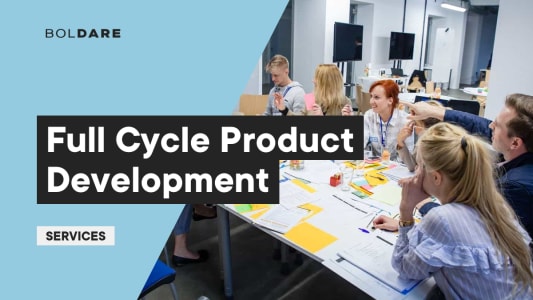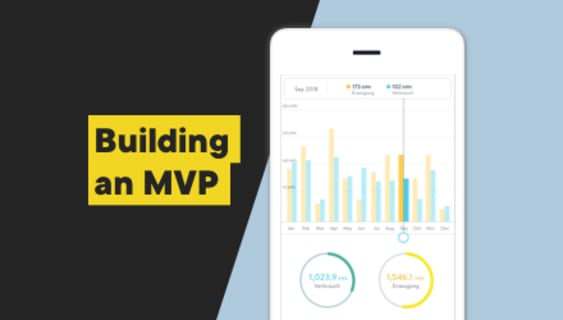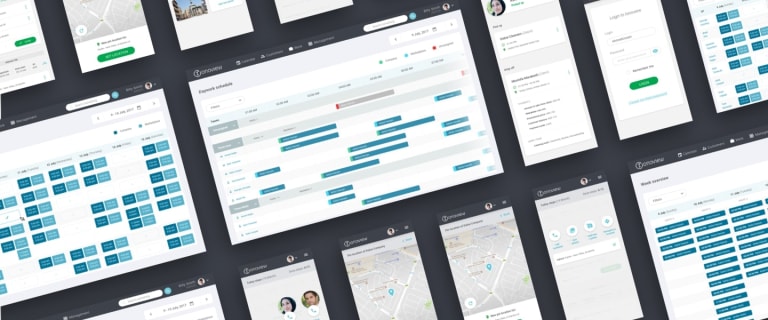Phase by phase - benefits of using Full Cycle Product Development
A digital product is more than just an app with a set of features. It’s more than just code. Above all, digital product should be a solution, a direct answer to user needs. The other side of the coin is the delivery of specific business goals for product owners and creators. That is why an app’s development strategy needs to take into account various market, business and technical factors. In this article, we present our approach to digital product development - full cycle product development or FCPD. What is full cycle product development? How can it help you build a successful product with high ROI? Find the answers here.

Table of contents
What is Full Cycle Product Development?
FCPD, short for Full Cycle Product Development, is an innovative approach to building software products. This idea is to a large extent similar to lean startup and in many places these concepts intertwine strongly. The main objective of FCPD is to test the right product hypothesis on the market with the right thing, i.e. a prototype or an MVP, while minimizing the risks on the business side (e.g. financial risk). We build digital products from the very first idea of a founder, through prototyping, MVPs to product-market fit, and scaling. The process consists of four comprehensive, complementary phases - each of them defined by distinct business and user goals, different product hypotheses, teams, and actions.
Dividing the life cycle of product development into stages helps to validate the primary assumptions at each step, and opens up the possibility of reacting to VUCA: adapting the product to the changing market, user needs, competition, technology, and so on. After 18 years of developing digital products, we find FCPD much safer and more profitable than the traditional waterfall approach where development tasks are planned and executed linearly.
4 phases of Full Cycle Product Development
The full cycle product development consists of four main phases which can be followed to create a new product from scratch as well as to improve existing software that is already on the market.
PHASE 1: PROTOTYPE
The digital prototyping phase allows you to visualize and test your software concept at low cost before investing in the development of a complete product. Prototypes can be created using no or low-code solutions as fast as in 1-2 weeks. Having a prototype of your digital application opens your way to meeting stakeholders and potential investors, as you already have something to show them. The prototype phase validates if there is a real and current need on the market for your software. It also verifies if a user’s problem can be solved with the proposed digital solution, and it answers a key question: is the idea realizable?
PHASE 2: MINIMUM VIABLE PRODUCT (MVP)
The goal of MVP development phase is to verify if users would actually find value in your app - value they would pay for. For this to happen, you need to release a basic version of your product - with only the most important features added, and gather users’ feedback. An MVP app can be developed and released to the market within 4-8 weeks.
PHASE 3: PRODUCT-MARKET FIT
Product-market fit is a key stage in the digital product development process. Here a specialized Scrum team investigates the target market to establish the number of actual and potential prospects, potential income, the time users spend on your app, their preferences, etc. This stage aims to fine-tune your product to fit the market’s needs. Product-market fit is an ongoing process, so it’s difficult to define its time range.
PHASE 4: SCALING
The product scaling phase is all about getting more users (usually in order to increase profits). This is usually done by addressing more specific user needs. The product is improved and the software’s architecture is prepared to serve a wider target group with a high level of loading speed and security. Scaling also helps to increase the number of unique users by releasing the software into new geographical markets. Just like in the product-market fit phase, it’s hard to define how long scaling should last. Usually, it lasts as long as it’s doable (or profitable) to respond to the emerging needs of the growing target group, with new product features and functionalities.
Why do we use FCPD at Boldare?
We use full cycle product development because it significantly reduces the risk of a product market failure and maximizes ROI. Thanks to its iterative nature, FCPD enables the validation of each product stage almost separately. So, in the case of a product’s failure in earlier stages, it saves the budget reserved for further development, making a potentially unsuccessful release less painful for the company’s budget.
Moreover, by constant verification of user needs, it prevents the product from losing out to the competition. FCPD’s holistic nature helps us to validate product ideas at each step of the software development process and adapt them to the market’s demands. This way the product is always in the build-measure-learn cycle. It’s constantly evolving and improving.
Such validation does not take place in traditional software development models. In most software development companies that are working with the so-called “waterfall” methodology, team members follow a list of tasks and requirements from the product owner, usually not considering the product’s real market value or user needs. FCPD allows us to spot risks and possibilities that arise in the market. It opens a door for product adjustment ideas and creates space to implement them at reduced cost, phase by phase.
At Boldare, we value FCPD because:
- it provides our clients with digital products that will improve their businesses, without wasting money,
- it’s based on facts and data - real feedback coming from users and metrics,
- it fits a product at various maturity levels,
- it’s holistic - it allows us to look at each product’s phase as a part of a bigger picture.
And what we value the most is the relatively high ROI for products developed within FCPD. We achieve this by creating software in rapid iterations which give scrum developers an open space for adjusting the direction of development, should it be needed.
Benefits of full cycle product development for digital product owners
As a minimum risk strategy, FCPD can save you a lot of money, time, and stress. How?
Imagine you want to design and release complex software. You have a vision and a few initial assumptions. You may even have access to more or less detailed marketing research results. But the technological domain is one of the most dynamic ones - even a single market occurrence can initiate a major change of business circumstances. Therefore, without monitoring the market situation, you might be treading on very thin ice. Why not play it safe?
Within FCPD, there are two phases that validate your initial product idea and face the market reality: the prototype and MVP phases. There is also the product-market fit phase for analyzing and checking your business model.
Second of all, at each stage of FCPD your app can be adapted or changed if the planned product doesn’t match the emerging needs of the target group. Moreover, here at Boldare, during each phase we implement so-called product discovery - we conduct in-depth data analysis and look for additional value we can add to the software. This way, your final product can solve real - and not just hypothetical - user issues.
And there is one more significant advantage of full cycle product development: it may never come to an end - it leaves the product’s creation process open and ready for future expansion, improvement, adaptation, or implementation of new functionalities.
FCPD teams
All members of Boldare’s FCPD teams know the goals of each product development phase and work closely with the client from the very beginning of the process. Constant validation of the product value helps them to provide product owners with accurate feedback and guidance through the next steps of the process. The teams are interdisciplinary and cross-functional - with various roles that can cooperate effectively to deliver the highest quality solutions. Among others, for FCPD we engage:
- frontend & backend developers,
- product designers specialized in UX and UI,
- scrum masters,
- business analysts,
- DevOps engineers,
- product strategists,
- QA/BA analysts.
We create FCPD teams based on specific product demands. For each phase of the cycle, we deploy the roles that support the product’s development in the most efficient and beneficial ways. Over the years, we have observed that teams working on different full cycle product development phases need different experience, skills, and tools. For example, a team focused on a prototype will be made up mostly of Product Designers and, if coding is necessary, Frontend Developers.
On the other hand, the scaling phase is a strongly technical one, and demands a heavy focus on software architecture. This is why our scaling teams will consist of DevOps Engineers and Solution Architects, among others.
As you can see, various products will need various teams, as there’s no “one solution fits all” path. If your products need to be delivered quickly as an MVP, then your team will need different skill sets and tools than a team that wants to scale a monolithic app carrying a risk of technical debt.
Conclusion
Full Cycle Product Development is a process of diving deep into each component of a business model. It helps to choose the right target group, the most effective tools and methods, and the best technology for your product to conquer the market. It widens your product’s vision and matches it with reality. It answers various questions at each stage of the process. And eventually, FCPD supports multidisciplinary teams in creating a product that brings value to the market and end users.
FCPD can be used to develop new digital ideas or to improve existing software, modernize it, grow its audience and broaden its features. If you are interested in discovering more about FCPD services at Boldare, don’t hesitate to visit our full cycle product development page and contact us with any questions you may have.
Share this article:









